算法原理部分
Dijkstra算法从起点开始逐步扩展,每一步为一个节点找到最短路径
循环以下命令:
1、最开始收录起点进入open list
2、选择open list中距离最小节点收录进closed list中
3、收录节点后遍历该节点的邻接节点,将邻接节点(若未访问则收录进open list中)更新其到起点距离
理解:每次都将open list中据起点最短距离的节点引入closed list中,直至遍历到终点,得到最短路径。
实例:
1、收录未访问的距离起点最小节点-即起点1收录进open list,括号内为距离起点距离。
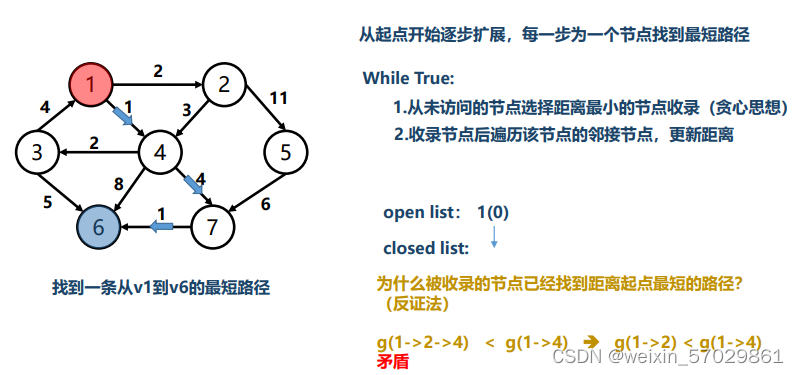
2、收录节点1进入closed list(由于在open list中距离最小),然后邻接节点2和4(邻接是由于1箭头指向只有2和4)收录进open list中,更新其到起点距离。并且收录open list中最小距离的4节点进入closed list中。

3、遍历4节点邻接节点(3、6、7),更新距离(更新3、6、7通过4节点到起点的距离,以下同理)收录进open list,选择距离最小节点2收录进closed list。

4、收录2邻接未访问的5节点进入open list,更新5节点距离。选择距离最小3节点进入closed list。
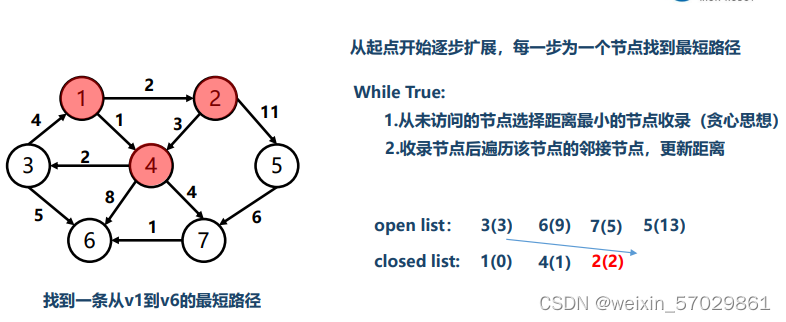
5、3节点无未收录邻接节点,则open list中无需收录节点。遍历邻接节点6,更新距离变为8。收录open list中最短距离节点7。
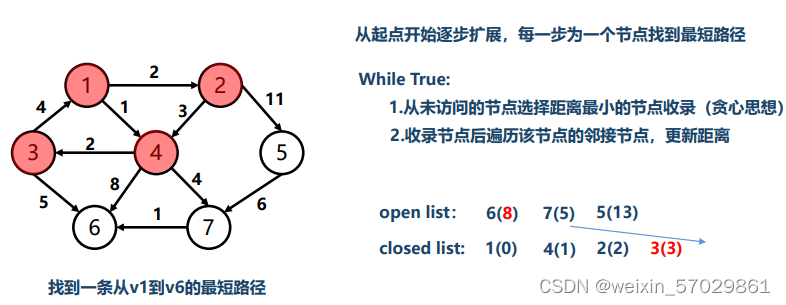
6、7点无未访问邻接节点,则无节点收录进openlist中。遍历邻接节点6,更新距离,open list中最短距离为终点6,则循环结束,得到最短距离路线。
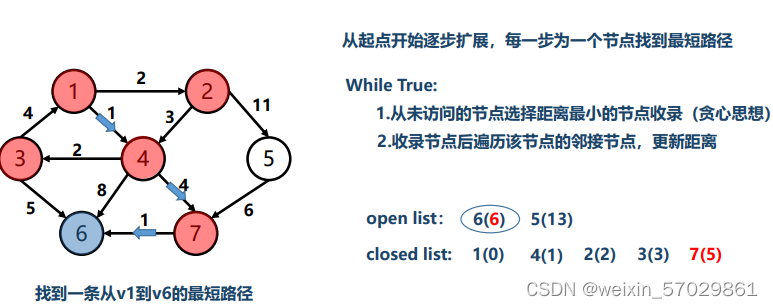
以下为代码思路:
其中红框内为算法主要思路,与上面描述可以对应。

栅格地图
以一定的大小将地图栅格化
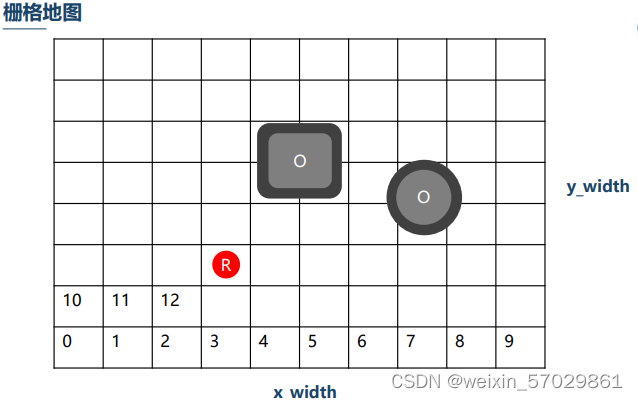
化为有权图则定义了路径的前进方向
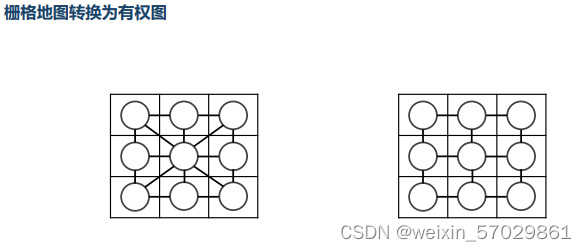
代码讲解
1、主体代码
def main():
# 设置起点和终点
sx = -5.0 # [m] # 设置起点
sy = -5.0 # [m]
gx = 50.0 # [m] # 设置终点
gy = 50.0 # [m]
grid_size = 2.0 # [m] 设置栅格大小
robot_radius = 1.0 # [m] 设置机器人大小
# 设置障碍物位置(黑色边缘)
ox, oy = [], []
for i in range(-10, 60):
ox.append(i)
oy.append(-10.0)
for i in range(-10, 60):
ox.append(60.0)
oy.append(i)
for i in range(-10, 61):
ox.append(i)
oy.append(60.0)
for i in range(-10, 61):
ox.append(-10.0)
oy.append(i)
for i in range(-10, 40):
ox.append(20.0)
oy.append(i)
for i in range(0, 40):
ox.append(40.0)
oy.append(60.0 - i)
if show_animation: # pragma: no cover
plt.plot(ox, oy, ".k")
plt.plot(sx, sy, "og")
plt.plot(gx, gy, "xb")
plt.grid(True) # 打开绘图网格线
plt.axis("equal") # 设置x轴、y轴刻度相同
dijkstra = Dijkstra(ox, oy, grid_size, robot_radius)
rx, ry = dijkstra.planning(sx, sy, gx, gy)
if show_animation: # pragma: no cover
plt.plot(rx, ry, "-r")
plt.pause(0.01)
plt.show()2、Dijkstra对象(将函数封装在一起)
1)__init__:初始化函数,将障碍物信息,栅格大小和机器人大小进行初始化
def __init__(self, ox, oy, resolution, robot_radius):
"""
Initialize map for planning
ox: x position list of Obstacles [m]
oy: y position list of Obstacles [m]
resolution: grid resolution [m]
rr: robot radius[m]
"""
self.min_x = None
self.min_y = None
self.max_x = None
self.max_y = None
self.x_width = None
self.y_width = None
self.obstacle_map = None
self.resolution = resolution
self.robot_radius = robot_radius
self.calc_obstacle_map(ox, oy) # 构建栅格地图
self.motion = self.get_motion_model() # 机器人运动方式
class Node:
def __init__(self, x, y, cost, parent_index):
self.x = x # index of grid
self.y = y # index of grid
self.cost = cost # g(n) 路径值
self.parent_index = parent_index # 栅格索引,最后用于寻找路径
def __str__(self):
return str(self.x) + "," + str(self.y) + "," + str(
self.cost) + "," + str(self.parent_index)self.calc_obstacle_map(ox, oy):构建栅格地图函数
def calc_obstacle_map(self, ox, oy):
''' 第1步:构建栅格地图 '''
# 获取地图边界值:最小值最大值
self.min_x = round(min(ox))
self.min_y = round(min(oy))
self.max_x = round(max(ox))
self.max_y = round(max(oy))
print("min_x:", self.min_x)
print("min_y:", self.min_y)
print("max_x:", self.max_x)
print("max_y:", self.max_y)
# 计算x.y方向具体栅格个数
self.x_width = round((self.max_x - self.min_x) / self.resolution)
self.y_width = round((self.max_y - self.min_y) / self.resolution)
print("x_width:", self.x_width)
print("y_width:", self.y_width)
# 初始化地图:地图可通行区域为False,据障碍物小于机器人半径的为True,见以下遍历障碍物
self.obstacle_map = [[False for _ in range(self.y_width)]
for _ in range(self.x_width)]
# 设置障碍物
# 其中前两层为遍历栅格,其中ix,iy为栅格下标
for ix in range(self.x_width):
x = self.calc_position(ix, self.min_x) # 计算具体位置
for iy in range(self.y_width):
y = self.calc_position(iy, self.min_y)
# def calc_position(self, index, minp):
pos = index * self.resolution + minp # 下标×栅格大小+最小位置=位置
return pos
# 遍历障碍物
for iox, ioy in zip(ox, oy):
d = math.hypot(iox - x, ioy - y) # 计算点到障碍物的距离
if d <= self.robot_radius: # 若点到障碍物距离小于机器人半径,则识别为障碍物
self.obstacle_map[ix][iy] = True
breakself.motion = self.get_motion_model():定义机器人运动方式
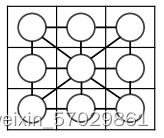
def get_motion_model():
# dx, dy, cost
# 转换为有权图,即机器人能运动的[x,y,运动距离]
motion = [[1, 0, 1], # 往右走
[0, 1, 1], # 往左走
[-1, 0, 1],
[0, -1, 1],
[-1, -1, math.sqrt(2)], #对角走
[-1, 1, math.sqrt(2)],
[1, -1, math.sqrt(2)],
[1, 1, math.sqrt(2)]]
return motion
2)Node:存储栅格节点
class Node:
def __init__(self, x, y, cost, parent_index):
self.x = x # index of grid
self.y = y # index of grid
self.cost = cost # g(n) 路径值
self.parent_index = parent_index # 栅格索引,最后用于寻找路径
def __str__(self):
return str(self.x) + "," + str(self.y) + "," + str(
self.cost) + "," + str(self.parent_index)3)planning(self, sx, sy, gx, gy):以节点的方式搜索路径
得到起始点和终点的节点,创建open_set和closed_set。将起点放入open_set中。
def planning(self, sx, sy, gx, gy):
# 得到起始点和终点的节点
start_node = self.Node(self.calc_xy_index(sx, self.min_x),
self.calc_xy_index(sy, self.min_y), 0.0, -1)
goal_node = self.Node(self.calc_xy_index(gx, self.min_x),
self.calc_xy_index(gy, self.min_y), 0.0, -1)
# calc_xy_index:round((position - minp) / self.resolution)
open_set, closed_set = dict(), dict() # key - value: hash表
open_set[self.calc_index(start_node)] = start_node # 存入起点
# calc_index(self, node): node.y * self.x_width + node.x 行×宽度+所在列循环下列命令
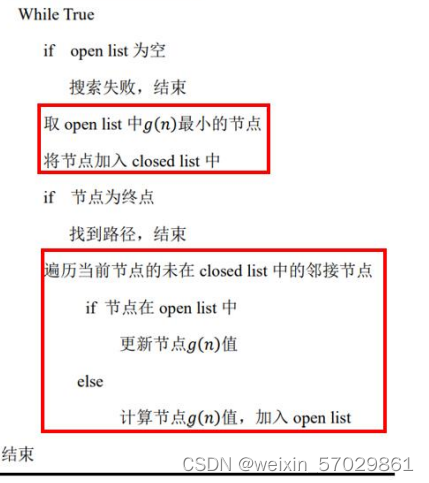
while 1:
c_id = min(open_set, key=lambda o: open_set[o].cost) # 取cost最小的节点
current = open_set[c_id]
# 画图
if show_animation: # pragma: no cover
plt.plot(self.calc_position(current.x, self.min_x),
self.calc_position(current.y, self.min_y), "xc")
# for stopping simulation with the esc key.
plt.gcf().canvas.mpl_connect(
'key_release_event',
lambda event: [exit(0) if event.key == 'escape' else None])
if len(closed_set.keys()) % 10 == 0:
plt.pause(0.001)
# 判断是否是终点
if current.x == goal_node.x and current.y == goal_node.y:
print("Find goal")
goal_node.parent_index = current.parent_index
goal_node.cost = current.cost
break
# 在open_set中删除cost最小节点
del open_set[c_id]
# 将最小节点加入closed_set中
closed_set[c_id] = current
# 基于运动模型扩展搜索网络
for move_x, move_y, move_cost in self.motion:
node = self.Node(current.x + move_x,
current.y + move_y,
current.cost + move_cost, c_id)
n_id = self.calc_index(node) # 计算新节点的key
if n_id in closed_set: # 是否收录该点若收录则进入下一循环
continue
if not self.verify_node(node): # 判断是否超过范围
continue
if n_id not in open_set: # 栅格可行则更新到起点的距离
open_set[n_id] = node # Discover a new node
else:
if open_set[n_id].cost >= node.cost:
# This path is the best until now. record it!
open_set[n_id] = node以下为上述代码中的 verify_node(node):判断节点是否超过范围
def verify_node(self, node):
px = self.calc_position(node.x, self.min_x)
py = self.calc_position(node.y, self.min_y)
# 判断是否超出边界
if px < self.min_x:
return False
if py < self.min_y:
return False
if px >= self.max_x:
return False
if py >= self.max_y:
return False
if self.obstacle_map[node.x][node.y]: # 判断是否为障碍物
return False
return True计算最后路径:calc_final_path(goal_node, closed_set)
rx, ry = self.calc_final_path(goal_node, closed_set) # 计算最后路径
return rx, ry def calc_final_path(self, goal_node, closed_set):
# generate final course
rx, ry = [self.calc_position(goal_node.x, self.min_x)], [
self.calc_position(goal_node.y, self.min_y)]
# 通过终点的父节点一直循环,直到返回到起点得到路径
parent_index = goal_node.parent_index # 返回终点的父节点索引
while parent_index != -1: # 父节点为-1时为起点
n = closed_set[parent_index]
rx.append(self.calc_position(n.x, self.min_x))
ry.append(self.calc_position(n.y, self.min_y))
parent_index = n.parent_index
return rx, ry以下附上总的算法代码
"""
Grid based Dijkstra planning
author: Atsushi Sakai(@Atsushi_twi)
"""
import matplotlib.pyplot as plt
import math
show_animation = True
class Dijkstra:
def __init__(self, ox, oy, resolution, robot_radius):
"""
Initialize map for planning
ox: x position list of Obstacles [m]
oy: y position list of Obstacles [m]
resolution: grid resolution [m]
rr: robot radius[m]
"""
self.min_x = None
self.min_y = None
self.max_x = None
self.max_y = None
self.x_width = None
self.y_width = None
self.obstacle_map = None
self.resolution = resolution
self.robot_radius = robot_radius
self.calc_obstacle_map(ox, oy) # 构建栅格地图
self.motion = self.get_motion_model() # 机器人运动方式
class Node:
def __init__(self, x, y, cost, parent_index):
self.x = x # index of grid
self.y = y # index of grid
self.cost = cost # g(n) 路径值
self.parent_index = parent_index # 栅格索引,最后用于寻找路径
def __str__(self):
return str(self.x) + "," + str(self.y) + "," + str(
self.cost) + "," + str(self.parent_index)
def planning(self, sx, sy, gx, gy):
"""
dijkstra path search
input:
s_x: start x position [m]
s_y: start y position [m]
gx: goal x position [m]
gx: goal x position [m]
output:
rx: x position list of the final path
ry: y position list of the final path
"""
# 得到起始点和终点的节点
start_node = self.Node(self.calc_xy_index(sx, self.min_x),
self.calc_xy_index(sy, self.min_y), 0.0, -1) # round((position - minp) / self.resolution)
goal_node = self.Node(self.calc_xy_index(gx, self.min_x),
self.calc_xy_index(gy, self.min_y), 0.0, -1)
open_set, closed_set = dict(), dict() # key - value: hash表
open_set[self.calc_index(start_node)] = start_node
while 1:
c_id = min(open_set, key=lambda o: open_set[o].cost) # 取cost最小的节点
current = open_set[c_id]
# show graph
if show_animation: # pragma: no cover
plt.plot(self.calc_position(current.x, self.min_x),
self.calc_position(current.y, self.min_y), "xc")
# for stopping simulation with the esc key.
plt.gcf().canvas.mpl_connect(
'key_release_event',
lambda event: [exit(0) if event.key == 'escape' else None])
if len(closed_set.keys()) % 10 == 0:
plt.pause(0.001)
# 判断是否是终点
if current.x == goal_node.x and current.y == goal_node.y:
print("Find goal")
goal_node.parent_index = current.parent_index
goal_node.cost = current.cost
break
# 在open_set中删除cost最小节点
del open_set[c_id]
# 将最小节点加入closed_set中
closed_set[c_id] = current
# 基于运动模型扩展搜索网络
for move_x, move_y, move_cost in self.motion:
node = self.Node(current.x + move_x,
current.y + move_y,
current.cost + move_cost, c_id)
n_id = self.calc_index(node) # 计算新节点的key
if n_id in closed_set: # 是否收录该点若收录则进入下一循环
continue
if not self.verify_node(node): # 判断是否超过范围
continue
if n_id not in open_set: # 栅格可行则更新到起点的距离
open_set[n_id] = node # Discover a new node
else:
if open_set[n_id].cost >= node.cost:
# This path is the best until now. record it!
open_set[n_id] = node
rx, ry = self.calc_final_path(goal_node, closed_set) # 计算最后路径
return rx, ry
# 求路径,其中rx,ry存储路径
def calc_final_path(self, goal_node, closed_set):
# generate final course
rx, ry = [self.calc_position(goal_node.x, self.min_x)], [
self.calc_position(goal_node.y, self.min_y)]
parent_index = goal_node.parent_index
while parent_index != -1:
n = closed_set[parent_index]
rx.append(self.calc_position(n.x, self.min_x))
ry.append(self.calc_position(n.y, self.min_y))
parent_index = n.parent_index
return rx, ry
def calc_position(self, index, minp):
pos = index * self.resolution + minp # 下标×栅格大小+最小位置=位置
return pos
def calc_xy_index(self, position, minp):
return round((position - minp) / self.resolution)
def calc_index(self, node):
return node.y * self.x_width + node.x
# 判断是否超出范围
def verify_node(self, node):
px = self.calc_position(node.x, self.min_x)
py = self.calc_position(node.y, self.min_y)
if px < self.min_x:
return False
if py < self.min_y:
return False
if px >= self.max_x:
return False
if py >= self.max_y:
return False
if self.obstacle_map[node.x][node.y]: # 是否为障碍物
return False
return True
def calc_obstacle_map(self, ox, oy):
''' 第1步:构建栅格地图 '''
# 获取地图边界值:最小值最大值
self.min_x = round(min(ox))
self.min_y = round(min(oy))
self.max_x = round(max(ox))
self.max_y = round(max(oy))
print("min_x:", self.min_x)
print("min_y:", self.min_y)
print("max_x:", self.max_x)
print("max_y:", self.max_y)
# 计算x.y方向具体栅格个数
self.x_width = round((self.max_x - self.min_x) / self.resolution)
self.y_width = round((self.max_y - self.min_y) / self.resolution)
print("x_width:", self.x_width)
print("y_width:", self.y_width)
# obstacle map generation
# 初始化地图
self.obstacle_map = [[False for _ in range(self.y_width)]
for _ in range(self.x_width)]
# 设置障碍物
# 其中前两层为遍历栅格,其中ix,iy为栅格下标
for ix in range(self.x_width):
x = self.calc_position(ix, self.min_x) # 计算具体位置
for iy in range(self.y_width):
y = self.calc_position(iy, self.min_y)
# 遍历障碍物
for iox, ioy in zip(ox, oy):
d = math.hypot(iox - x, ioy - y) # 计算点到障碍物的距离
if d <= self.robot_radius: # 若点到障碍物距离小于机器人半径,则识别为障碍物
self.obstacle_map[ix][iy] = True
break
@staticmethod
def get_motion_model():
# dx, dy, cost
# 转换为有权图,即机器人能运动的[x,y,运动距离]
motion = [[1, 0, 1], # 往右走
[0, 1, 1], # 往左走
[-1, 0, 1],
[0, -1, 1],
[-1, -1, math.sqrt(2)],
[-1, 1, math.sqrt(2)],
[1, -1, math.sqrt(2)],
[1, 1, math.sqrt(2)]]
return motion
def main():
# 设置起点和终点
sx = -5.0 # [m] # 设置起点
sy = -5.0 # [m]
gx = 50.0 # [m] # 设置终点
gy = 50.0 # [m]
grid_size = 2.0 # [m] 设置栅格大小
robot_radius = 1.0 # [m] 设置机器人大小
# 设置障碍物位置(黑色边缘)
ox, oy = [], []
for i in range(-10, 60):
ox.append(i)
oy.append(-10.0)
for i in range(-10, 60):
ox.append(60.0)
oy.append(i)
for i in range(-10, 61):
ox.append(i)
oy.append(60.0)
for i in range(-10, 61):
ox.append(-10.0)
oy.append(i)
for i in range(-10, 40):
ox.append(20.0)
oy.append(i)
for i in range(0, 40):
ox.append(40.0)
oy.append(60.0 - i)
if show_animation: # pragma: no cover
plt.plot(ox, oy, ".k")
plt.plot(sx, sy, "og")
plt.plot(gx, gy, "xb")
plt.grid(True) # 打开绘图网格线
plt.axis("equal") # 设置x轴、y轴刻度相同
dijkstra = Dijkstra(ox, oy, grid_size, robot_radius)
rx, ry = dijkstra.planning(sx, sy, gx, gy)
if show_animation: # pragma: no cover
plt.plot(rx, ry, "-r")
plt.pause(0.01)
plt.show()
if __name__ == '__main__':
main()





















 1133
1133











 被折叠的 条评论
为什么被折叠?
被折叠的 条评论
为什么被折叠?








